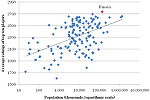


ChessBase 17 - Mega package - Edition 2024
It is the program of choice for anyone who loves the game and wants to know more about it. Start your personal success story with ChessBase and enjoy the game even more.
Larger countries are typically better at chess than small ones. By “better”, I mean according to the ratings of the top players or total number of grandmasters. Thus, whenever large and small countries are compared, it is common to hear objections that the comparison was unfair. The same goes when rich and poor countries are compared.
This leads to two questions: First, is it possible to take into account the population size or average income of countries when comparing them? Second, is it possible to calculate how important population and GDP are in determining chess success? Fortunately, yes, using something known as regression analysis in statistics.

Figure 1. Relationship between average rating of top players and population
The figure above is a scatterplot of various countries’ population against the average ratings of their top ten players in May 2011. What we can do is to draw a line of best fit. This line minimizes the gaps between all the points and the lines.
One immediately notices that there is indeed a positive relationship between population and the average ratings as the top ten players. However, there are clearly a lot of other factors affecting these average ratings, as few of the points lie on the line. If population was the only factor involved, all points would fit neatly onto the line.
We can see that Russia (the point in red) is still much stronger than we would expect based on its population.
Doing something similar with GDP per capita (adjusted for cost of living) results in the diagram below. As Hong Kong is below the line, we say that based on its GDP, Hong Kong is much weaker than what we expect it to be.

Figure 2. Relationship between average rating of top players and GDP per capita (adjusted for cost of living)
It is possible to adjust for both factors simultaneously. One can then calculate the expected rating of the top ten players of each country based on its population and GDP. Thereafter, one can see which countries are stronger than expected, and which are weaker than expected.
In the table below, AvgRtg refers to the average rating of the top ten players, and Expected refers to the expected average based solely on the country’s GDP and population. If the difference is positive, then the country is stronger than expected, given its population and GDP.
| No |
Country |
AvgRtg |
Expected |
Difference |
| 1 |
Armenia |
2654 |
2185 |
+469 |
| 2 |
Georgia |
2611 |
2200 |
+411 |
| 3 |
Moldova |
2480 |
2136 |
+344 |
| 4 |
Montenegro |
2452 |
2124 |
+328 |
| 5 |
Iceland |
2509 |
2188 |
+321 |
| 6 |
Azerbaijan |
2639 |
2320 |
+319 |
| 7 |
Bulgaria |
2623 |
2322 |
+301 |
| 8 |
Ukraine |
2696 |
2398 |
+298 |
| 9 |
Serbia |
2595 |
2310 |
+285 |
| 10 |
Bosnia Herzegovina |
2499 |
2230 |
+269 |
Table 1. Top chess playing countries, after accounting for population and GDP
Armenia comes out tops. This suggests it may have one or more of the following: a good national federation, strong governmental support for chess, or other aspects of strong chess culture.
Many of the top countries were formerly communist. However, they do not dominate the list. There are many examples of good chess culture in countries that were not formerly communist. Such countries that have average ratings 100 points or more higher than expected are Iceland, Faroe Islands, Israel, Philippines, Monaco, the Netherlands, Denmark, Sweden, Greece, Paraguay, Norway, and Argentina. To the best of my knowledge, none of these countries have state support for chess at the level of any former Soviet Bloc country.
For the complete list of countries, you may see pages 10 to 13 of my full study. For the processes and equations used, you may see pages 1 to 9 of my full study.
One would get roughly similar results if one used the total number of titled players as a measure of chess success, rather than average ratings of top players.
Another important result that emerged from my analysis was that population and GDP do not explain more than half of a country’s chess success (even when combined). In fact, depending on how one measures chess success, these factors account for 17% to 40% of a country’s chess success at present. Population and GDP do positively influence a country’s chess success, but being small or poor does not place a country at a large disadvantage. True, it is not so easy to compete with big and rich countries. However, a number of the top 20 nations (according to average rating of top 10, unadjusted for population or GDP) are either small or poor: Armenia, Hungary, Israel, and the Netherlands are four uncontroversial exceptions.

|
Links
Leung Weiwen is a second year undergraduate at the Singapore Management University. He majors in Economics & Applied Statistics, and is currently on exchange in Utrecht University in the Netherlands. He used to play chess for his school and Singapore, and has been involved with the Singapore Chess Federation in various capacities. |